Poison Ivy
It’s been a while since I talked about Wild Grape Vines, so I thought I’d follow up with a post about another vine that is abundant in Ohio. There’s an old rhyme associated with this vine- “Leaflets three, let it be.”
Toxicodendron radicans, commonly known as eastern poison ivy or poison ivy, is a poisonous Asian and North American flowering plant that is well known for causing Urushiol-induced contact dermatitis, an itchy, irritating, and sometimes painful rash in most people who touch it. It is caused by urushiol, a clear liquid compound in the plant’s sap. The species is variable in its appearance and habit, and despite its common name it is not a true ivy (Hedera), but rather a member of the cashew and pistachio family. Toxicodendron radicans is commonly eaten by many animals, and the seeds are consumed by birds, but poison ivy is most often thought of as an unwelcome weed.
When I was a kid, I got poison ivy rash all the time playing outdoors. That’s no surprise, because this vine is very common. Take a stroll in the woods and chances are you’ll see a lot of it here in Ohio.
Poison Ivy can not only be found on the forest floor (sometimes in shrublike bunches), but climbing high into trees as well. Next time you’re in the woods, look at tree trunks closely- you may see it (or a few other vine species) there, looking like leaves growing out of the trunk, but really coming out of vines. Old vines can get really thick, as in Tarzan-swinging thick. But don’t ignore the ground either- sometimes Poison Ivy covers whole areas of the woodland floor.
Sometimes the leaves almost cover tree trunks. After winter, the vines can leaf again. It is quite persistent.
You may have noticed that the trifolate leaves (famously clustered in 3s) can vary in shape. This can make it tricky to avoid, unless you just avoid all leaves growing in clusters of 3. Most of those are Poison Ivy anyway 🙂
In the autumn, Poison Ivy turns yellow and red, adding to the colorful leaf show. I’ve seen a bit of the color change already in late August.
What makes Poison Ivy so itchy? Urishiol oil. This oil is the bane of many a rash-covered individual.
Urushiol-induced contact dermatitis is the allergic reaction caused by poison ivy. In extreme cases, a reaction can progress to anaphylaxis. Around 15% to 25% of people have no allergic reaction to urushiol, but most people will have a greater reaction with repeated or more concentrated exposure.
Urushiol binds to the skin on contact, where it causes severe itching that develops into reddish inflammation or non-coloured bumps, and then blistering. These lesions may be treated with Calamine lotion, Burow’s solution compresses, dedicated commercial poison ivy itch creams, or baths to relieve discomfort, though recent studies have shown some traditional medicines to be ineffective. Over-the-counter products to ease itching—or simply oatmeal baths and baking soda—are now recommended by dermatologists for the treatment of poison ivy.
The oozing fluids released by scratching blisters do not spread the poison. The fluid in the blisters is produced by the body and it is not urushiol itself…Urushiol oil can remain active for several years, so handling dead leaves or vines can cause a reaction. In addition, oil transferred from the plant to other objects (such as pet fur) can cause the rash if it comes into contact with the skin. Clothing, tools, and other objects that have been exposed to the oil should be washed to prevent further transmission.
The urushiol compound in poison ivy is not a defensive measure; rather, it helps the plant to retain water. It is frequently eaten by animals such as deer and bears.
In the late spring or early summer, teeny little white flowers bloom, but they are very easy to miss. These flowers will turn into berries (called drupes), green in color at first but eventually turning white.
Poison Ivy berries are edible to animals, and I’ve seen many a bird eating them. They are a favorite of Yellow-Rumped Warblers, a rare warbler species that eats something other than insects.
I’ve seen woodpeckers eat the berries too. The seeds pass through birds and will grow where they fall- some shade is all they need. This helps to spread the plant widely.
Berries that don’t get eaten can be easily noticed in the winter, when all of the leaves have gone. This is a good food source in the lean season for animals and birds alike.
I’m not as allergic to Poison Ivy as I was when I was a kid. Every once in a while I’ll still get a few bumps on my ankles along the sock line if I wear shorts in the woods, but it doesn’t spread over me like it used to. That’s fine with me!


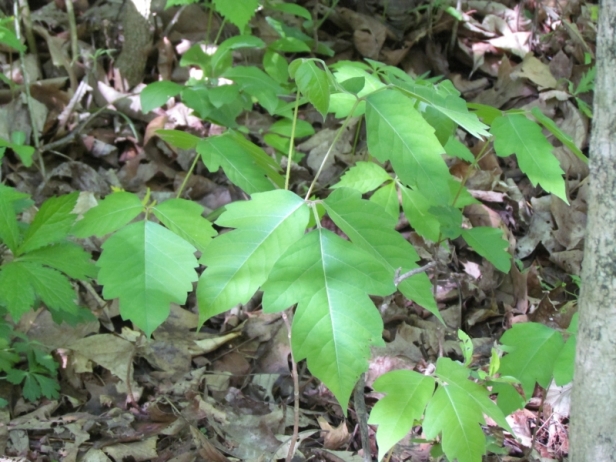

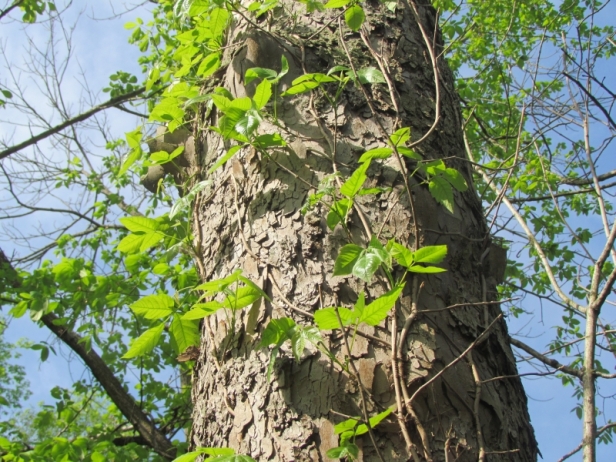
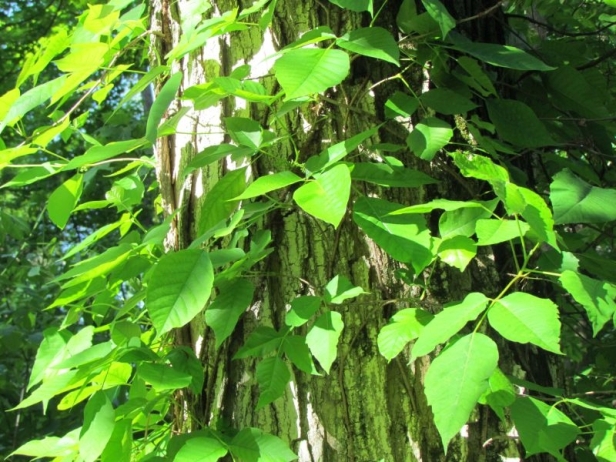
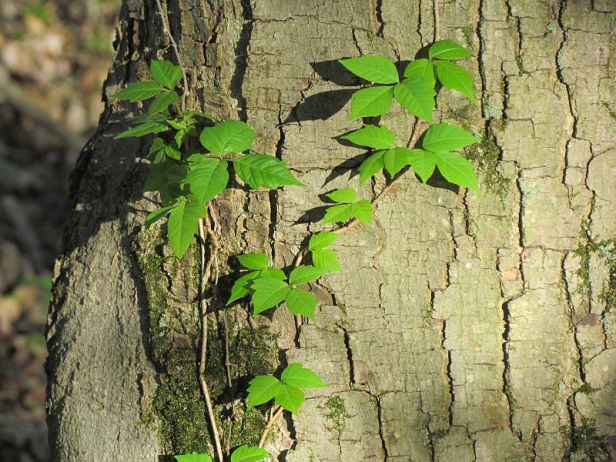

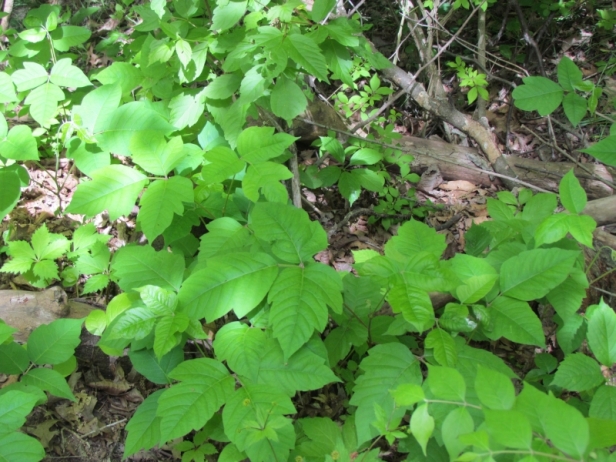


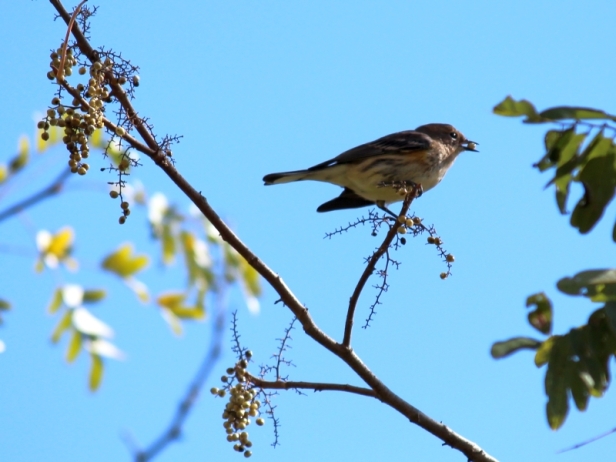





I would keep well covered up.
Sage advice, tootlepedal!
Great photos.
Thanks, Jane!
Thanks so much for all the information, especially the photos. I’m never quite sure what is or isn’t poison ivy in the woods so I appreciated seeing examples of it and its berries in all their different colors. Some of it gets into gardens, too, as I learned from weeding my daughter’s garden in North Carolina. Didn’t enjoy that rash!
Thanks Barbara! Yeah they can get into gardens and the result is rather bothersome 🙂
I did not know that poison ivy climbs trees! I will look more carefully now before I rip down vining plants! Great “public service” announcment!
You’re welcome, Inger- sometimes I look around in the woods and Poison Ivy is everywhere!
It always amazes me just how much poison ivy I encounter just in Griggs Reservoir Park!
I hear you Bob and Donna- Poison Ivy, Wild Grapes, Virginia Creeper- the Big Three of vines cover much of the woods!
Last week I read the book In Praise of Poison Ivy by Anita Sanchez. Given this post, you might enjoy reading it too.
My favorite thing about the plant is the way its leaves turn colors in the fall. Or maybe that I’ve never had a poison ivy reaction.
Thanks for the recommendation, Steve- it’s a LOT easier to appreciate it if you aren’t highly susceptible to the oil!
I don’t know if I’m not susceptible or if I’ve just been lucky. Not knowing, I don’t push my luck.